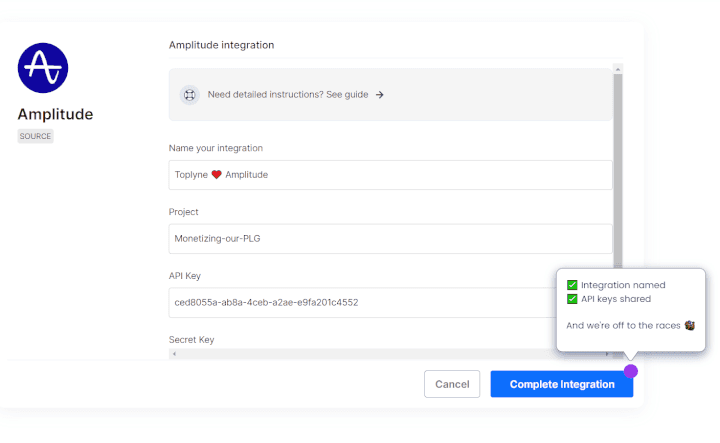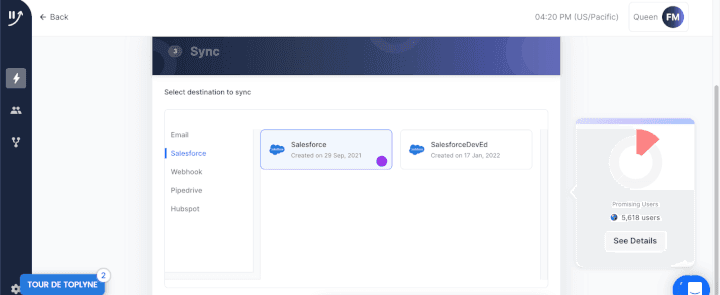Product-Led Growth vs Marketing-Led Growth: Which One’s for You?
Product-Led Growth vs Marketing-Led Growth: Which One’s for You?
Product-Led Growth vs Marketing-Led Growth: Which One’s for You?
Does product-led growth or marketing-led growth suit your company better? Find out the answer in our detailed comparison article.
Does product-led growth or marketing-led growth suit your company better? Find out the answer in our detailed comparison article.
Does product-led growth or marketing-led growth suit your company better? Find out the answer in our detailed comparison article.



Lower customer acquisition costs and higher user retention rates.
These are just two of the juiciest benefits of Product Led Growth (PLG)!
What more could you ask for as a SaaS company?
Not so fast!
Many companies stick to good ol’ marketing led growth (MLG) since it offers them increased brand awareness and helps them cover a wider customer base.
Picking a side in the product led growth vs marketing led growth debate can be as tough as choosing between Black Widow and Wonder Woman. 🙆

What’s the ultimate pick then?
You’ll know soon enough!
In this article, we’ll highlight six key differences between product-led growth and marketing-led growth.
Additionally, we’ll discuss the benefits of both strategies and introduce you to a mind-blowing tool that can help you identify the most promising leads.
Let’s go!
Product-Led Growth vs Marketing-Led Growth: A Detailed Comparison
Here’s a deep dive into the key differences between PLG vs. MLG:
1. Overview
While PLG focuses on creating a mindblowing product and enhancing user experience, MLG emphasizes generating valuable product marketing content.
A. Product-Led Growth:
Product-led growth is a business framework where the product is the driving force behind customer acquisition and revenue growth.
Get all the deets about product-led growth, including the benefits of this strategy and how to implement one.
How?
A PLG company offers self-serve sign-up options that allow any customer to start using the product right away. This way, they can avoid sitting through long sales monologues and demos.
In fact, the product led growth strategy gives you a way shorter buying cycle than the traditional sales led approach!
Tip: Want a frictionless sales process in your PLG company?
Get the best of both worlds with product-led sales.
Here’s a breakdown of the steps involved in the product led growth strategy:
Acquisition: Your marketing team usually acquires freemium users through organic and paid search. There’s a self-serve model and no salesperson is involved in setting up accounts at this stage. Product experience tours and in-app notifications help you onboard new users and show them around your product from the moment they sign up.
After using your product, customers go gaga over it, sharing its value with other potential prospects. 📢
Retention: When the customer keeps using your product to tackle an everyday challenge, they consider integrating it into their regular workflow.
Monetization: Finally, there comes the point where your customers and product become inseparable!
Your customer gets so enamored by your product for operations that they become paid subscribers. It also helps them unlock other functionalities that can make their life easier.
Further reading: Learn what a product-led growth flywheel is, along with its key user segments and actions.
B. Marketing-Led Growth:
In marketing led growth, prospects sign up for a product demo after reading a blog, watching a video, or downloading an ebook.
The strategy relies on your marketers’ ability to create the perfect web of content that captivates your target audience.
Here’s a breakdown of the steps involved in a marketing led growth strategy:
Acquisition: Your marketing team generates website traffic through social media, SEO, and ads. Customers discover blog content, ebooks, newsletters, or infographics related to your SaaS product and fill up a form to sign up for a demo. A salesperson gets in touch with the lead to deliver the demo and activate a free trial.
Retention: Your team sends emails, in-app messages, and notifications to retain the customer. They even communicate the product’s actual value, sharing case studies, use cases, customer success stories, and more.
Monetization: You send lead nurturing email campaigns and make phone calls to users to give them demos and convert them into paid users.
2. Point of Contact
Companies implementing the product led approach let customers get a direct product experience through free trials or freemium pricing models.
Throughout the customer journey, there’s minimal interaction with the sales rep or marketing team.
Introverts be like…

Psst…here’s a comprehensive comparison between product-led growth and sales-led growth.
In MLG, a user discovers your product through an ad or other content marketing resources. They may schedule a demo or download a white paper for more information.
Later, they’re passed on to the sales team, who try to seal the deal.
3. Product Value
MLG focuses more on building a perceived value of the product rather than delivering actual value to the user.
Users are shown product marketing ads, videos, newsletters, etc., that create a certain perception of the product in their mind.
Creating some hype and getting your customers' hopes up is all fine, but if you fail to deliver a world-class user experience, they may feel cheated.
Say your product is an accounting app. Your marketing content emphasizes how the app can help eliminate administrative burden related to taxes or even automate monthly reports.
Such marketing may lure a potential customer into trying your product. However, disaster occurs when your customers use the product and find it too difficult to navigate.
Almost like promising them a heavenly slice of pizza and later on serving this.

Thankfully, product-led companies bridge the gap between perceived value and experienced value by letting users experience the product value firsthand.
More importantly, the product-led approach allows you to collect customer feedback (during the free trial period), which helps you improve product usage and conversion rates.
And by developing a strong customer feedback loop, PLG companies can enhance their customer success strategy.
4. Quality and Quantity of Leads
PLG companies acquire product qualified leads (PQLs), whereas MLG companies focus on marketing qualified leads (MQLs).
A marketing qualified lead is usually further away from product purchase than a product qualified lead. In the product led growth strategy, the user experiences the product value directly and is more motivated to make the purchase.
Moreover, the buying intent of MQLs is gauged by things like filling out a form, downloading ebooks, subscribing to newsletters, etc. These actions may indicate their interest but not necessarily for buying.
Considering the quantitative aspect - MQLs can sometimes be higher in number than your PQLs. But this may require your sales team to dedicate time to MQLs, who may never become profitable customers.
So they may be chasing leads on the company’s dime and valuable time!
Whereas the product-led growth model depends on the lead’s engagement with the SaaS product and how satisfying the customer experience has been. So even though your PQLs may be lower in number, the conversion rate is usually higher.
5. Customer Acquisition Cost (CAC)
The sales team in MLG companies launch campaigns for an audience that may or may not be very qualified.
For example, sales teams at many companies will give you a call if you download an ebook.
As you can imagine, this is a costly way to scale. Even if you do set up a lot of meetings, only a small percentage of those customers will end up becoming paid customers.
However, a product-led strategy targets individuals who spend a lot of time using your product and are ready to make their big entrance into the buying cycle!
The result?
By focusing time and resources on high-potential customers, you weed out leads that never wanted your product in the first place.
And what’s even better is that your potential customers might even become your marketers (for free! 🤩).
What do we mean?
By offering a fantastic product experience, you’ll encourage users to share their favorite experiences with the community through online reviews.
So when you implement product led sales, you get more out of your customer acquisition efforts. Consequently, the customer acquisition cost of your SaaS company falls.
6. Suitability
Product-led growth is suitable for any SaaS company offering low-cost products and straightforward onboarding processes.
PLG is also suitable for SaaS products that have collaboration features. Products like Slack, Calendly, and Zoom have built-in virality and encourage users to share the tool with others.
MLG is ideal for software companies with high-end products or products requiring consultative selling. It works best for customers who require a bit of hand-holding - particularly enterprise customers.
Much like how you need that nerdy friend to understand any Christopher Nolan movie 😅.

But instead of relying on a sales rep (as traditionally done in a sales led approach), MLG companies use content marketing resources to support customers.
For instance, HubSpot and Lattice have a fantastic repository of videos, blogs, and courses. It helps them demonstrate the product value for new or existing customers, boosting user acquisition and retention.
But how does the MLG or PLG strategy contribute to SaaS growth and drive business profits?
Product-Led Growth vs Marketing-Led Growth: Key Benefits
The benefits of MLG include increased brand awareness and comprehensive knowledge of the target audience (due to prior market research).
The strategy helps you share your brand’s mission and other relatable stories through blog posts, product videos, infographics, and more.
And when you tell your story well, your target audience will dig your vibe!

Long story short – Mission ‘Brand Awareness’ accomplished. 😎
Product led companies want their users to discover the product value ASAP.
As a result, PLG can help you improve the customer journey, increase customer retention and help you upsell.
Additionally, the product manager in PLG companies employ both sales and marketing tactics to create a well-rounded growth strategy.
However, one minor challenge the product team faces is knowing when a customer is about to convert. Fortunately, there’s a powerful solution in the market that can help any product led growth company do just that!
Discover High-Intent Customers with Toplyne
As a product manager, you can rely on Toplyne to find high-potential leads. It helps you develop a cracker of a PLG strategy 🔥, so no potential customer falls through the cracks.
How?
The tool lets your product management team segment customers into different personas.

This way, the sales team in your product-led company can solely focus on the promising users and stop chasing pointless leads.
And guess what, there’s more to it!
Toplyne can also help your product management team:
Determine the best GTM strategy (re-marketing/automated messaging/sales assist motion/in-product nudges) for new and existing customers.

Quickly integrate with popular CRM tools (Salesforce, Hubspot) and product analytics infrastructures (Amplitude, Segment).

Send every product qualified lead to your chosen sales channel (email, Salesforce, Webhook, etc.)

Craft an in-product tailored customer experience to encourage users to invite more users.
Companies like Canva, Invideo, and OpenPhone have already monetized their product-led growth model using Toplyne.
Ready to join the big leagues?
Implement PLG to Soak in a Pool of Profits 💰
While MLG is great for building your brand’s reputation, PLG can help you create the best customer experience to keep users happy.
In a product-led company, it all comes down to developing a product that’s a head-turner and an absolute showstopper! 👠
PLG also goes a long way in improving both user acquisition and customer retention rates.
Sounds like an offer you can’t refuse?
Sign up for Toplyne for free today to target high-intent users and rake in huge profits!

Lower customer acquisition costs and higher user retention rates.
These are just two of the juiciest benefits of Product Led Growth (PLG)!
What more could you ask for as a SaaS company?
Not so fast!
Many companies stick to good ol’ marketing led growth (MLG) since it offers them increased brand awareness and helps them cover a wider customer base.
Picking a side in the product led growth vs marketing led growth debate can be as tough as choosing between Black Widow and Wonder Woman. 🙆

What’s the ultimate pick then?
You’ll know soon enough!
In this article, we’ll highlight six key differences between product-led growth and marketing-led growth.
Additionally, we’ll discuss the benefits of both strategies and introduce you to a mind-blowing tool that can help you identify the most promising leads.
Let’s go!
Product-Led Growth vs Marketing-Led Growth: A Detailed Comparison
Here’s a deep dive into the key differences between PLG vs. MLG:
1. Overview
While PLG focuses on creating a mindblowing product and enhancing user experience, MLG emphasizes generating valuable product marketing content.
A. Product-Led Growth:
Product-led growth is a business framework where the product is the driving force behind customer acquisition and revenue growth.
Get all the deets about product-led growth, including the benefits of this strategy and how to implement one.
How?
A PLG company offers self-serve sign-up options that allow any customer to start using the product right away. This way, they can avoid sitting through long sales monologues and demos.
In fact, the product led growth strategy gives you a way shorter buying cycle than the traditional sales led approach!
Tip: Want a frictionless sales process in your PLG company?
Get the best of both worlds with product-led sales.
Here’s a breakdown of the steps involved in the product led growth strategy:
Acquisition: Your marketing team usually acquires freemium users through organic and paid search. There’s a self-serve model and no salesperson is involved in setting up accounts at this stage. Product experience tours and in-app notifications help you onboard new users and show them around your product from the moment they sign up.
After using your product, customers go gaga over it, sharing its value with other potential prospects. 📢
Retention: When the customer keeps using your product to tackle an everyday challenge, they consider integrating it into their regular workflow.
Monetization: Finally, there comes the point where your customers and product become inseparable!
Your customer gets so enamored by your product for operations that they become paid subscribers. It also helps them unlock other functionalities that can make their life easier.
Further reading: Learn what a product-led growth flywheel is, along with its key user segments and actions.
B. Marketing-Led Growth:
In marketing led growth, prospects sign up for a product demo after reading a blog, watching a video, or downloading an ebook.
The strategy relies on your marketers’ ability to create the perfect web of content that captivates your target audience.
Here’s a breakdown of the steps involved in a marketing led growth strategy:
Acquisition: Your marketing team generates website traffic through social media, SEO, and ads. Customers discover blog content, ebooks, newsletters, or infographics related to your SaaS product and fill up a form to sign up for a demo. A salesperson gets in touch with the lead to deliver the demo and activate a free trial.
Retention: Your team sends emails, in-app messages, and notifications to retain the customer. They even communicate the product’s actual value, sharing case studies, use cases, customer success stories, and more.
Monetization: You send lead nurturing email campaigns and make phone calls to users to give them demos and convert them into paid users.
2. Point of Contact
Companies implementing the product led approach let customers get a direct product experience through free trials or freemium pricing models.
Throughout the customer journey, there’s minimal interaction with the sales rep or marketing team.
Introverts be like…

Psst…here’s a comprehensive comparison between product-led growth and sales-led growth.
In MLG, a user discovers your product through an ad or other content marketing resources. They may schedule a demo or download a white paper for more information.
Later, they’re passed on to the sales team, who try to seal the deal.
3. Product Value
MLG focuses more on building a perceived value of the product rather than delivering actual value to the user.
Users are shown product marketing ads, videos, newsletters, etc., that create a certain perception of the product in their mind.
Creating some hype and getting your customers' hopes up is all fine, but if you fail to deliver a world-class user experience, they may feel cheated.
Say your product is an accounting app. Your marketing content emphasizes how the app can help eliminate administrative burden related to taxes or even automate monthly reports.
Such marketing may lure a potential customer into trying your product. However, disaster occurs when your customers use the product and find it too difficult to navigate.
Almost like promising them a heavenly slice of pizza and later on serving this.

Thankfully, product-led companies bridge the gap between perceived value and experienced value by letting users experience the product value firsthand.
More importantly, the product-led approach allows you to collect customer feedback (during the free trial period), which helps you improve product usage and conversion rates.
And by developing a strong customer feedback loop, PLG companies can enhance their customer success strategy.
4. Quality and Quantity of Leads
PLG companies acquire product qualified leads (PQLs), whereas MLG companies focus on marketing qualified leads (MQLs).
A marketing qualified lead is usually further away from product purchase than a product qualified lead. In the product led growth strategy, the user experiences the product value directly and is more motivated to make the purchase.
Moreover, the buying intent of MQLs is gauged by things like filling out a form, downloading ebooks, subscribing to newsletters, etc. These actions may indicate their interest but not necessarily for buying.
Considering the quantitative aspect - MQLs can sometimes be higher in number than your PQLs. But this may require your sales team to dedicate time to MQLs, who may never become profitable customers.
So they may be chasing leads on the company’s dime and valuable time!
Whereas the product-led growth model depends on the lead’s engagement with the SaaS product and how satisfying the customer experience has been. So even though your PQLs may be lower in number, the conversion rate is usually higher.
5. Customer Acquisition Cost (CAC)
The sales team in MLG companies launch campaigns for an audience that may or may not be very qualified.
For example, sales teams at many companies will give you a call if you download an ebook.
As you can imagine, this is a costly way to scale. Even if you do set up a lot of meetings, only a small percentage of those customers will end up becoming paid customers.
However, a product-led strategy targets individuals who spend a lot of time using your product and are ready to make their big entrance into the buying cycle!
The result?
By focusing time and resources on high-potential customers, you weed out leads that never wanted your product in the first place.
And what’s even better is that your potential customers might even become your marketers (for free! 🤩).
What do we mean?
By offering a fantastic product experience, you’ll encourage users to share their favorite experiences with the community through online reviews.
So when you implement product led sales, you get more out of your customer acquisition efforts. Consequently, the customer acquisition cost of your SaaS company falls.
6. Suitability
Product-led growth is suitable for any SaaS company offering low-cost products and straightforward onboarding processes.
PLG is also suitable for SaaS products that have collaboration features. Products like Slack, Calendly, and Zoom have built-in virality and encourage users to share the tool with others.
MLG is ideal for software companies with high-end products or products requiring consultative selling. It works best for customers who require a bit of hand-holding - particularly enterprise customers.
Much like how you need that nerdy friend to understand any Christopher Nolan movie 😅.

But instead of relying on a sales rep (as traditionally done in a sales led approach), MLG companies use content marketing resources to support customers.
For instance, HubSpot and Lattice have a fantastic repository of videos, blogs, and courses. It helps them demonstrate the product value for new or existing customers, boosting user acquisition and retention.
But how does the MLG or PLG strategy contribute to SaaS growth and drive business profits?
Product-Led Growth vs Marketing-Led Growth: Key Benefits
The benefits of MLG include increased brand awareness and comprehensive knowledge of the target audience (due to prior market research).
The strategy helps you share your brand’s mission and other relatable stories through blog posts, product videos, infographics, and more.
And when you tell your story well, your target audience will dig your vibe!

Long story short – Mission ‘Brand Awareness’ accomplished. 😎
Product led companies want their users to discover the product value ASAP.
As a result, PLG can help you improve the customer journey, increase customer retention and help you upsell.
Additionally, the product manager in PLG companies employ both sales and marketing tactics to create a well-rounded growth strategy.
However, one minor challenge the product team faces is knowing when a customer is about to convert. Fortunately, there’s a powerful solution in the market that can help any product led growth company do just that!
Discover High-Intent Customers with Toplyne
As a product manager, you can rely on Toplyne to find high-potential leads. It helps you develop a cracker of a PLG strategy 🔥, so no potential customer falls through the cracks.
How?
The tool lets your product management team segment customers into different personas.

This way, the sales team in your product-led company can solely focus on the promising users and stop chasing pointless leads.
And guess what, there’s more to it!
Toplyne can also help your product management team:
Determine the best GTM strategy (re-marketing/automated messaging/sales assist motion/in-product nudges) for new and existing customers.

Quickly integrate with popular CRM tools (Salesforce, Hubspot) and product analytics infrastructures (Amplitude, Segment).

Send every product qualified lead to your chosen sales channel (email, Salesforce, Webhook, etc.)

Craft an in-product tailored customer experience to encourage users to invite more users.
Companies like Canva, Invideo, and OpenPhone have already monetized their product-led growth model using Toplyne.
Ready to join the big leagues?
Implement PLG to Soak in a Pool of Profits 💰
While MLG is great for building your brand’s reputation, PLG can help you create the best customer experience to keep users happy.
In a product-led company, it all comes down to developing a product that’s a head-turner and an absolute showstopper! 👠
PLG also goes a long way in improving both user acquisition and customer retention rates.
Sounds like an offer you can’t refuse?
Sign up for Toplyne for free today to target high-intent users and rake in huge profits!

Related Articles




Behavioral Retargeting: A Game-Changer in the Cookieless Era
Unlock the power of behavioral retargeting for the cookieless future! Learn how it personalizes ads & boosts conversions. #behavioralretargeting




All of Toplyne's 40+ Badges in the G2 Spring Reports
Our customers awarded us 40+ badges in G2's Summer Report 2024.




Unlocking the Full Potential of Google PMax Campaigns: Mastering Audience Selection to Double Your ROAS
Copyright © Toplyne Labs PTE Ltd. 2024
Copyright © Toplyne Labs PTE Ltd. 2024
Copyright © Toplyne Labs PTE Ltd. 2024
Copyright © Toplyne Labs PTE Ltd. 2024